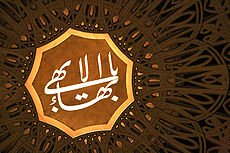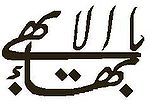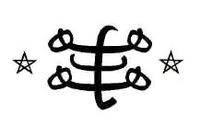
Bahá'í symbols
Encyclopedia

Bahá'í Faith
The Bahá'í Faith is a monotheistic religion founded by Bahá'u'lláh in 19th-century Persia, emphasizing the spiritual unity of all humankind. There are an estimated five to six million Bahá'ís around the world in more than 200 countries and territories....
. While the five-pointed star
Five-pointed star
A five-pointed star is a very common ideogram throughout the world. If the colinear edges are joined together a pentagram is produced, which is the simplest of the unicursal star polygons, and a symbol of mystical and magical significance....
is the symbol of the religion, being used to represent the human body and Messengers of God
Manifestation of God
The Manifestation of God is a concept in the Bahá'í Faith that refers to what are commonly called prophets. The Manifestations of God are a series of personages who reflect the attributes of the divine into the human world for the progress and advancement of human morals and civilization...
, more common symbols include the nine-pointed star, the Greatest Name, and the Ringstone symbol, representing perfection, and the Messengers of God.
Five-pointed star


Five-pointed star
A five-pointed star is a very common ideogram throughout the world. If the colinear edges are joined together a pentagram is produced, which is the simplest of the unicursal star polygons, and a symbol of mystical and magical significance....
, or haykal is the symbol of the Bahá'í Faith
Bahá'í Faith
The Bahá'í Faith is a monotheistic religion founded by Bahá'u'lláh in 19th-century Persia, emphasizing the spiritual unity of all humankind. There are an estimated five to six million Bahá'ís around the world in more than 200 countries and territories....
as mentioned by Shoghi Effendi
Shoghi Effendi
Shoghí Effendí Rabbání , better known as Shoghi Effendi, was the Guardian and appointed head of the Bahá'í Faith from 1921 until his death in 1957...
, the Guardian of the Bahá'í Faith: "Strictly speaking the 5-pointed star is the symbol of our Faith, as used by the Báb
Báb
Siyyid `Alí Muḥammad Shírází was the founder of Bábism, and one of three central figures of the Bahá'í Faith. He was a merchant from Shíráz, Persia, who at the age of twenty-four claimed to be the promised Qá'im . After his declaration he took the title of Báb meaning "Gate"...
and explained by Him." The five-pointed star has been used as the outline of special letters or tablets
Tablet (religious)
A tablet, in the religious context, is a term traditionally used for religious texts.Jews and Christians believe that Moses brought the Ten Commandments from Mount Sinai in the form of two stone tablets. According to the Book of Exodus, God delivered the tablets twice, the first set having been...
by both the Báb and Bahá'u'lláh.
Haykal is a loan word from the Hebrew word hēyḵāl which means temple and specifically Solomon's Temple
Solomon's Temple
Solomon's Temple, also known as the First Temple, was the main temple in ancient Jerusalem, on the Temple Mount , before its destruction by Nebuchadnezzar II after the Siege of Jerusalem of 587 BCE....
in Jerusalem. In Arabic, the word also means the body or form of something, particularly the human body
Human body
The human body is the entire structure of a human organism, and consists of a head, neck, torso, two arms and two legs.By the time the human reaches adulthood, the body consists of close to 100 trillion cells, the basic unit of life...
. In the Bahá'í tradition, the haykal was established by the Báb
Báb
Siyyid `Alí Muḥammad Shírází was the founder of Bábism, and one of three central figures of the Bahá'í Faith. He was a merchant from Shíráz, Persia, who at the age of twenty-four claimed to be the promised Qá'im . After his declaration he took the title of Báb meaning "Gate"...
— the person who told of Bahá'u'lláh's
Bahá'u'lláh
Bahá'u'lláh , born ' , was the founder of the Bahá'í Faith. He claimed to be the prophetic fulfilment of Bábism, a 19th-century outgrowth of Shí‘ism, but in a broader sense claimed to be a messenger from God referring to the fulfilment of the eschatological expectations of Islam, Christianity, and...
coming — who represented the haykal as a five-pointed star representing the human body as a head, two hands, and two feet. The Báb wrote many letters, tablets, prayers and more in the shape of a five-pointed star, including some that included many derivatives of the word Bahá’ (see below).
In Bahá'u'lláh's writings, specifically the Súriy-i-Haykal (Tablet of the Temple), while the meaning of temple remains present, the haykal is used mainly to mean the human body, but particularly the body of the Manifestation of God
Manifestation of God
The Manifestation of God is a concept in the Bahá'í Faith that refers to what are commonly called prophets. The Manifestations of God are a series of personages who reflect the attributes of the divine into the human world for the progress and advancement of human morals and civilization...
— a messenger from God — and the person of Bahá'u'lláh himself. The combination of the use of haykal as a temple and a human body is combined to refer to a human temple, specifically the body of the Manifestation of God. In the Tablet, the haykal is also used to refer the word of God, which is revealed by the Manifestations of God.
The Greatest Name

God
God is the English name given to a singular being in theistic and deistic religions who is either the sole deity in monotheism, or a single deity in polytheism....
has 99 names, and in some Islamic traditions it is believed that there is a special hidden 100th name which is the greatest. In Bahá'í belief the Greatest Name is Bahá’ , translated as "glory" or "splendour". Many symbols of the Bahá'í Faith derive their significance from the word Bahá’, and it is the root word used in many other names and phrases including Bahá'í (a follower of Bahá'), Bahá'u'lláh (Glory of God), `Abdu'l-Bahá (Servant of Glory), Yá Bahá'u'l-Abhá (Oh Thou Glory of the Most Glorious), and Alláh-u-Abhá
Alláh-u-Abhá
Alláh-u-Abhá is a greeting that Bahá'ís use when they meet each other. Abhá is a superlative of the word Bahá', and a form of the Greatest Name. Bahá'ís are asked to repeat the phrase Alláh-u-Abhá 95 times per day, as described by Bahá'u'lláh, founder of the Bahá'í Faith in the Kitáb-i-Aqdas, his...
(God is Most Glorious).
Bahá'u'lláh often referred to Bahá'ís in his writings as "the people of Bahá’", and in addition, the Báb sent a tablet to Bahá'u'lláh with 360 derivatives of the word Bahá’. Along with daily prayers, Bahá'ís are encouraged to recite the phrase "Alláh-u-Abhá" 95 times in a form of meditation.

Arabic language
Arabic is a name applied to the descendants of the Classical Arabic language of the 6th century AD, used most prominently in the Quran, the Islamic Holy Book...
calligraphic rendering of "Yá Bahá'u'l-Abhá" ( usually translated as "O Thou the Glory of the Most Glorious!"). This rendering was originally drawn by the early Bahá'í calligrapher Mishkín Qalam, and later adopted by Bahá'ís everywhere.
Since the symbol refers more directly to the Name of God and of the Messenger of God
Manifestation of God
The Manifestation of God is a concept in the Bahá'í Faith that refers to what are commonly called prophets. The Manifestations of God are a series of personages who reflect the attributes of the divine into the human world for the progress and advancement of human morals and civilization...
, than any other symbol in the Bahá'í Faith, it is not generally used in a casual manner or to adorn the personal artifacts that are put to common use. The symbol can usually be seen in Bahá'í homes and rings that are produced on a limited scale.
Nine-pointed star

Abjad numerals
The Abjad numerals are a decimal numeral system in which the 28 letters of the Arabic alphabet are assigned numerical values. They have been used in the Arabic-speaking world since before the 8th century Arabic numerals...
system of Isopsephy
Isopsephy
Isopsephy is the Greek word for the practice of adding up the number values of the letters in a word to form a single number. The early Greeks used pebbles arranged in patterns to learn arithmetic and geometry....
, the word Bahá' has a numerical equivalence of 9, and thus there is frequent use of the number 9 in Bahá'í symbols. The most commonly used symbol connected to the number 9 is the nine-pointed star
Enneagram (geometry)
In geometry, an enneagram is a nine-pointed geometric figure. It is sometimes called a nonagram.-Regular enneagram:A regular enneagram is constructed using the same points as the regular enneagon but connected in fixed steps...
; there is no particular design of the nine-pointed star that is used more often than others. While the star is not a part of the teachings of the Bahá'í Faith, it is commonly used as an emblem representing "9", because of the association of number 9 with perfection, unity and Bahá’.
The number 9 also comes up several times in Bahá'í history and teachings. On the significance of the number 9, Shoghi Effendi
Shoghi Effendi
Shoghí Effendí Rabbání , better known as Shoghi Effendi, was the Guardian and appointed head of the Bahá'í Faith from 1921 until his death in 1957...
wrote:
"Concerning the number nine: the Bahá'ís reverence this for two reasons, first because it is considered by those who are interested in numbers as the sign of perfection. The second consideration, which is the more important one, is that it is the numerical value of the word "Bahá’"…
"Besides these two significances the number nine has no other meaning. It is, however, enough to make the Bahá'ís use it when an arbitrary number is to be chosen."
Ringstone symbol


`Abdu'l-Bahá
‘Abdu’l-Bahá , born ‘Abbás Effendí, was the eldest son of Bahá'u'lláh, the founder of the Bahá'í Faith. In 1892, `Abdu'l-Bahá was appointed in his father's will to be his successor and head of the Bahá'í Faith. `Abdu'l-Bahá was born in Tehran to an aristocratic family of the realm...
, Bahá'u'lláh's son and successor, and as its name implies, is the most common symbol found on rings worn by Bahá'ís, but it is also used on necklaces, book covers, and paintings. It consists of two stars (haykal) interspersed with a stylized Bahá’. The lower line is said to represent humanity and the world of creation, the upper line the world of God, and the middle line represents the special station of Manifestation of God
Manifestation of God
The Manifestation of God is a concept in the Bahá'í Faith that refers to what are commonly called prophets. The Manifestations of God are a series of personages who reflect the attributes of the divine into the human world for the progress and advancement of human morals and civilization...
and the world of revelation
Revelation
In religion and theology, revelation is the revealing or disclosing, through active or passive communication with a supernatural or a divine entity...
; the vertical line is the Primal Will or Holy Spirit proceeding from God through the Manifestations to humanity. The position of Manifestation of God in this symbol is said to be the linking point to God. The two stars or haykals represent Bahá'u'lláh and the Báb.
External links
- The Art of the Greatest Name
- The Nine-Pointed Star, History and Symbolism - By the Universal House of Justice, 1999
- Story of the Ringstone Symbol - www.spiritual-education.org
- Greatest Name Song and Poem Site used with permission, a public site

